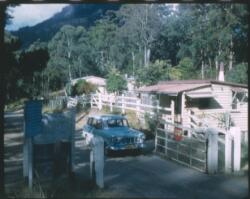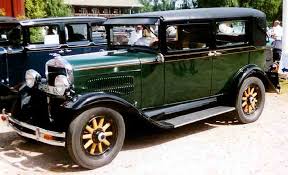On Boxing Day, 1936, in a soft-topped Essex motorcar and towing a trailer full of camping gear, my father Maurice, his two younger brothers, his father, E.B., and his grandfather C.B. left Nambour to drive to Melbourne. The Third Test was due to begin in January 1937, at the Melbourne Cricket Ground, and they wanted to see Don Bradman bat.
It was to be a two-week road trip – touring, as they called it then – through New South Wales and Victoria. The family often went touring. They didn’t know this would be their last long trip together.
My Dad, Maurice, then an eighteen-year-old, kept a trip journal, full of details that seem quaint to travellers in the twenty-first century: border crossings, road conditions, camping, communications, access to funds along the way.
 Maurice’s trip journal 1936-1937
Maurice’s trip journal 1936-1937Now, in June 2020, the year of COVID-19, southerners are stopped at the border, not allowed to cross into Queensland without a special permit.
 “Long delays as Queensland-NSW border closed for first time since Spanish flu in 1919” The Guardian, 26 Mar 2020
“Long delays as Queensland-NSW border closed for first time since Spanish flu in 1919” The Guardian, 26 Mar 2020In 1936, cars and trucks going from Queensland to New South Wales were stopped and inspected at border gates. New South Wales didn’t want Queenslanders bringing cattle ticks south with them to infest stock. They still don’t.
Queensland has always been seen by southerners as a wild, bizarre place, a frontier region with its own quirky rules. We are the state of cyclones, cane toads, crocodiles, cattle ticks and mad politicians, and we’re oddly proud of that.
In normal times in the twenty-first century, cars drive straight across the borders without a pause; but still, when I cross into New South Wales on the Pacific Motorway, speeding past the big red border sculpture along the Tugun Bypass, or down through the rugged border mountains near Mount Lindesay, or at Wallangarra on the New England Highway, or Goondiwindi on the Newell, it feels like an event, with a little sense of visiting a foreign country; and crossing back into Queensland feels like coming home.
 Qld-N.S.W Border, Tugun goldcoastbulletin.com.au
Qld-N.S.W Border, Tugun goldcoastbulletin.com.auIn 1936, Queensland travellers were advised to obtain an Interstate Motorists Permit before travelling south. Dad’s family crossed the border at Mount Lindesay, and in Armidale, their first stop in New South Wales, according to Maurice’s journal they sought the cop-shop, where a policeman was persuaded to come out and search for engine-numbers, chassis-numbers etc., and to give us an interstate pass and windscreen sticker.
 The Border Gate at Mt Lindesay Frank Hurley, c.1961
The Border Gate at Mt Lindesay Frank Hurley, c.1961They slept that night on the floor of a fruit packing shed outside Armidale, on the property of a family friend. From then on, nights were spent in their tent in what were called Tourist Camping Parks, or at likely spots beside the road wherever it suited them, as you could do in those less regulated days.
In 1936, the population of Australia was less than six million. Now, over twenty million people call Australia home, driving nearly twenty million vehicles, and so we can’t just set up camp wherever we want to anymore.
Roads were narrow and often steep and winding. Even major roads were rough and unsealed in places. There were many railway level crossings on the New England Highway; and instead of speeding high over the Hawkesbury River on the M1 as we do now, travellers crossed by Peat’s Ferry. It nine years later when the river was bridged at that point.
 Launch of the new Peat’s Ferry, 1930 records.nsw.gov.au
Launch of the new Peat’s Ferry, 1930 records.nsw.gov.auThirty-seven other cars went on the ferry with the family’s Essex, and as they waited in line to board, Maurice and his brothers ate a bottle of local oysters, sold to waiting travellers by enterprising boys. Hawkesbury River oysters. That hasn’t changed.
 Essex Super Six Model E, 1931 – probably the model used on this road trip commons.wikipedia.org
Essex Super Six Model E, 1931 – probably the model used on this road trip commons.wikipedia.orgRoad trip communications are different now, in ways that were unimaginable then. We use our phones to check directions and distances, traffic conditions and weather; to book accommodation, and listen to music, talking books and podcasts; all while travelling. To check weather conditions before heading to Mount Kosciusko, E.B. booked a trunk call to the weather bureau from Canberra Post Office, and to communicate with home they sent telegrams.
We’ve done over 100,000 kilometres in our Forester, with one puncture. We have it serviced every 12,000 kilometres or so. On highways, cruise control is set at 100 or 110 kph. Maurice and his family, on their 1936-37 trip of 3397 miles (5467 kilometres), changed three tyres because of punctures, stopped three times for grease-ups and oil changes, broke a spring, had the steering adjusted and repairs done to the trailer, and were pleased when on one straight road in Victoria they reached fifty miles (eighty kilometres) an hour.
As we all had to before the arrival of Bank Cards in the late 1970s, they’d sent specimen signatures ahead from their home branch of the Commonwealth Bank so they could withdraw money along the way. No ATMs or plastic cards then.
On 4 January 1937, Maurice and his group at last got to the M.C.G. to see Bradman. They arrived late. As Maurice put it, We went there on the day on which the world’s record cricket crowd – 87,000 – was present. We were among the 17,000 for which there was no room. We caught glimpses of the play – sometimes three quarters of a wicket keeper, or a single fieldsman and a patch of grass. One of the batsmen we could sometimes glimpse was Bradman.
 Bradman at the crease, Third Test, second innings, Melbourne January 1937 20 Great Ashes Moments No. 4, The Guardian, 9 May 2013
Bradman at the crease, Third Test, second innings, Melbourne January 1937 20 Great Ashes Moments No. 4, The Guardian, 9 May 2013Next day they had to leave for home. With no car radio, they stopped along the way to hear the progress of the Test: in a café in Wangaratta, and again in a park at Albury, where people lay on the bank of the Murray in bathers, listening to the broadcast description of Bradman’s and Fingleton’s fine stand blaring forth from a speaker hung in a tree in the park.
 The Murray River near Albury, 1930s. flickr.com
The Murray River near Albury, 1930s. flickr.comNext day, at a loudspeaker at a small refreshment stall at Hume Dam, we heard Bradman score the single which took his score to two hundred.
Bradman ended up scoring 270 runs – a record for a number seven batsman; and England lost the Test.
Sixteen days after leaving Nambour, Maurice and the family arrived back home. Maurice typed up the story, added maps and illustrations and had the journal sturdily bound.
 Maurice’s hand-drawn map of the journey through N.S.W.
Maurice’s hand-drawn map of the journey through N.S.W.A month later, he started university. Three years later, he joined the 2/26th infantry battalion. He shipped out of Melbourne in 1941, bound for Singapore, part of the troop build-up in the face of the threat of invasion by Japan.
The following February, Singapore surrendered to the Japanese Imperial Army, and in 1943 Maurice was among the thousands of prisoners of war who were packed into rice wagons and taken north by train to work as slaves, building the infamous Thai-Burma railway.
In October 1945, twenty-seven years old, thin, jaundiced and exhausted, Maurice came home again to Nambour, to Mum, and to their little son.
At once, he bought a new car; and within two years, he and Mum were off on another road trip – the first of a new generation. My earliest memory is standing in the back seat of that little car, as kids did in those less regulated days, looking between my parents’ shoulders at a long, narrow road leading off into the distance.
My Dad got me addicted to road trips early. I’ve never gotten over it.

Great story – thanks, Bud. How adventurous were our parents and grandparents. Grandpa and Grandma made several other long trips, if my memory serves me, although I seem to recall that Grandma did few.
Best wishes in these tiring times. Our holiday in Australia, planned for August-September, is unlikely to take place. It would almost certainly involve periods of quarantine in Australia on arrival and VN on return.
Love from all of us,
Ian
On Sat, Jun 20, 2020 at 5:44 PM Queensland Stories wrote:
> roseobrienwriter posted: “On Boxing Day, 1936, in a soft-topped Essex > motorcar and towing a trailer full of camping gear, my father Maurice, his > two younger brothers, his father, E.B., and his grandfather C.B. drove from > Nambour to Melbourne. The Third Test was due to begin in Jan” >
LikeLike
Thanks, Ian. Yes, they loved to travel! I’ve got photos they took of the Sydney Harbour Bridge under construction, in about 1928 and 1931. Also at Mt Kosciusko. Nan went on that one.
And as the song says, “Someday we’ll all be together once more…” Stay well. Love to all.
LikeLike
Goodness, what an adventure! I know the feeling you describe of crossing the border from NSW into Queensland. There’s always a sense of pride and thankfulness that we live where we do. For one thing, the weather is amazing. My parents took us on caravan trips from an early age and I still love doing that.
LikeLiked by 1 person
What a wonderful story. I recently came across a photo entitled “Les on the road to Sydney”. There was no date but I’m guessing Dad’s young brother Les would have set off some time after WW2. I must say that Les was in better shape than the road, somewhere between Melbourne and Sydney and quite unmade.
LikeLiked by 1 person
It’s amazing how recently it was that roads were quite dreadful! The Eyre Highway across the Nullabor was still unsealed in the late 1970s!
LikeLike
Yes, we drove the partly unsealed Nullarbor in a Mini Moke back in 1975.
LikeLiked by 1 person
Wow – that must have been fun! The things we did…!
LikeLike